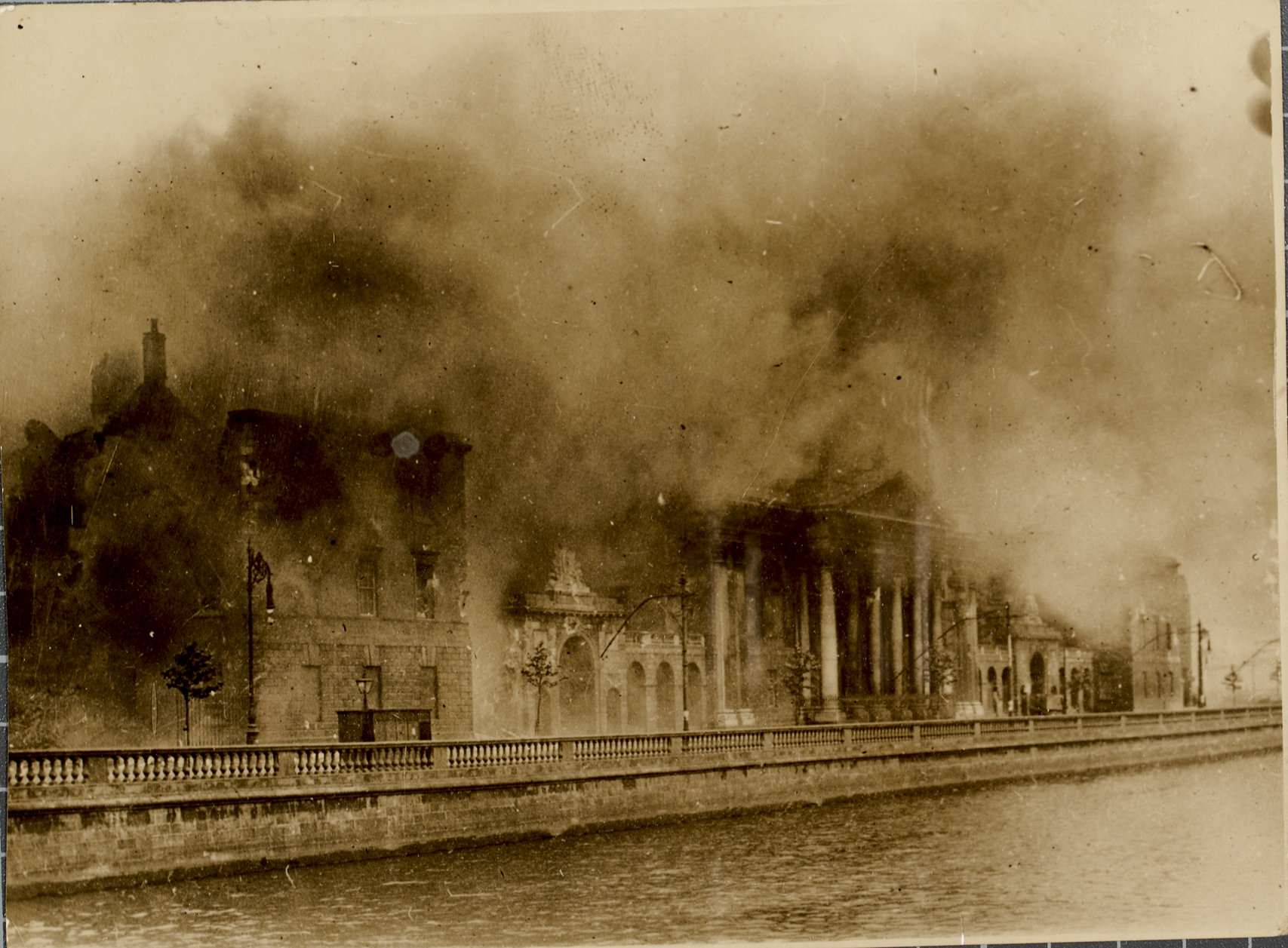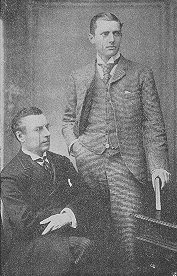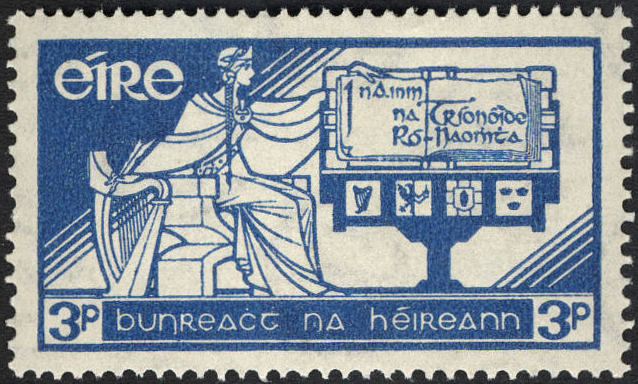|
The Emergency (Ireland)
The Emergency () was a state of emergency in the independent state of Republic of Ireland, Ireland in the Second World War, throughout which Irish neutrality during World War II, the state remained neutral. It was proclaimed by Dáil Éireann on 2 September 1939, allowing the passage of the Emergency Powers Act 1939 by the Oireachtas the following day. This gave sweeping powers to the government, including internment, censorship of the press and correspondence, and control of the economy. The Emergency Powers Act lapsed on 2 September 1946, although the Emergency was not formally ended until 1976. Background of the Emergency On 6 December 1922, following the Anglo-Irish Treaty that ended the Anglo-Irish War, War of Independence, the island of Ireland became an autonomous dominion, known as the Irish Free State. On 7 December 1922, the parliament of the six north-eastern counties, already known as Northern Ireland, voted to opt out of the Irish Free State and remain in the United K ... [...More Info...] [...Related Items...] OR: [Wikipedia] [Google] [Baidu] |
Emergency Service Medal
The Emergency Service Medal (Irish language, Irish: ''An Bonn Seirbhíse Éigeandála'') is a military decoration of the Republic of Ireland that was awarded to servicemen who served during The Emergency (Ireland), The Emergency from 1939 to 1946. Due to faulty record keeping during the period, the total number of Medals issued is not known. Description The medal is made of bronze, on the front there is an image of a woman with a dog beside her, along the top the words ''"Re na Práinne"'' are inscribed in Irish. On the back there is an olive branch with "1939" to one side of it, and "1946" to the other. At the top there are words inscribed in Irish, the words are different across the 11 variants, with each being the Irish name of the organisation or group the individual who received the medal is a member of. The example Medal shown reads ''"An Fórsa Cosanta Áitiúil"'', which was the Irish name for the Local Security Forces. The Ribbon is scarlet red with 1 or 2 white str ... [...More Info...] [...Related Items...] OR: [Wikipedia] [Google] [Baidu] |
Irish Civil War
The Irish Civil War (; 28 June 1922 – 24 May 1923) was a conflict that followed the Irish War of Independence and accompanied the establishment of the Irish Free State, an entity independent from the United Kingdom but within the British Empire. The civil war was waged between the Provisional Government of Ireland (1922), Provisional Government of Ireland and the Irish Republican Army (1922–1969), Anti-Treaty IRA over the Anglo-Irish Treaty. The Provisional Government (that became the Free State in December 1922) supported the terms of the treaty, while the Anglo-Irish Treaty Dáil vote#Anti-Treaty, anti-Treaty opposition saw it as a betrayal of the Irish Republic proclaimed during the Easter Rising of 1916. Many of the combatants had fought together against the British in the Irish Republican Army (1919–1922), Irish Republican Army during the War of Independence and had divided after that conflict ended and the Irish Republican Army and the Anglo-Irish Treaty, treaty neg ... [...More Info...] [...Related Items...] OR: [Wikipedia] [Google] [Baidu] |
Irish Republican Army (1922–1969)
The Irish Republican Army (IRA) of 1922–1969 was a sub-group of the original pre-1922 Irish Republican Army (1919–1922), Irish Republican Army, characterised as the Anti-Treaty IRA for its opposition to the Anglo-Irish Treaty. It existed in various forms until 1969, when the IRA split again into the Provisional Irish Republican Army, Provisional IRA and Official Irish Republican Army, Official IRA. The original Irish Republican Army fought a guerrilla war against British rule in Ireland in the Irish War of Independence between 1919 and 1921. The Anglo-Irish Treaty signed on 6 December 1921 ended this war by granting most of the island a great degree of independence, but with six counties in the north staying within the United Kingdom as the new jurisdiction of Northern Ireland. The IRA units in the other 26 counties (that were to become the Irish Free State) split between supporters and opponents of the Treaty. The anti-Treatyites, sometimes referred to by National Army (Ire ... [...More Info...] [...Related Items...] OR: [Wikipedia] [Google] [Baidu] |
Lough Swilly
Lough Swilly () in Ireland is a glacial fjord or sea inlet lying between the western side of the Inishowen Peninsula and the Fanad Peninsula, in County Donegal. Along with Carlingford Lough and Killary Harbour it is one of three glacial fjords in Ireland. Name Both Lough Swilly () and the adjoining River Swilly () have the same derivation, and are sometimes associated with a legendary multi-eyed sea monster, ''Suileach'', that was reputedly killed by Saint Colmcille (521–597). In ''The Origin and History of Irish Names of Places'' (1900), the historian Patrick Weston Joyce writes that ''súil'' may refer to whirlpools or to eyes and that ''suileach'' means "abounding in eyes or whirlpools". Geography and ecology Located on the Fanad Peninsula, in County Donegal, the northern extremities of the lough are marked by Fanad Head with its lighthouse and Dunaff Head. Towns situated on the lough include Buncrana on Inishowen and Rathmullan on the western side. At the southern ... [...More Info...] [...Related Items...] OR: [Wikipedia] [Google] [Baidu] |
Cobh
Cobh ( ,), known from 1849 until 1920 as Queenstown, is a seaport town on the south coast of County Cork, Republic of Ireland, Ireland. With a population of 14,148 inhabitants at the 2022 census of Ireland, 2022 census, Cobh is on the south side of Great Island in Cork Harbour and home to Ireland's only dedicated Passenger terminal (maritime), cruise terminal. Tourism in the area draws on the maritime and emigration legacy of the town. Facing the town are Spike Island, County Cork, Spike and Haulbowline islands. On a high point in the town stands St Colman's Cathedral, Cobh, St Colman's, the cathedral church of the Roman Catholic Diocese of Cloyne. It is one of the list of tallest structures in Ireland, tallest buildings in Ireland, standing at 91.4 metres (300 ft). Name The village on Great Island was known as "Ballyvoloon", a transliteration of the Irish ''Baile Ui-Mhaoileoin'' (English: "O'Malone's town"), while the Royal Navy port, established in the 1750s, became kno ... [...More Info...] [...Related Items...] OR: [Wikipedia] [Google] [Baidu] |
Berehaven
Castletownbere (), or Castletown Berehaven, is a port town in County Cork, Ireland. It is on the Beara Peninsula by Berehaven Harbour. A regionally important fishing port, the town also serves as a commercial and retail hub for the local hinterland. Located on the Wild Atlantic Way, tourism is also important to the local economy. The area is the setting for Daphne du Maurier's 1943 novel '' Hungry Hill'' named after the nearby mountain of the same name. History and name The Irish name of the town () originally referred to a MacCarthy dynasty castle which once stood in the area. This should not be confused with Dunboy Castle – two miles west of the town – which was the seat of the O'Sullivan Beare family. Donal Cam O'Sullivan Beare, together with other Gaelic lords and with Spanish aid, rebelled against the English Crown. During the Siege of Dunboy the castle was reduced by the forces of Elizabeth I in 1602. He then retreated with his followers to Leitrim. O'Sullivan Bea ... [...More Info...] [...Related Items...] OR: [Wikipedia] [Google] [Baidu] |
Treaty Ports (Ireland)
Following the establishment of the Irish Free State, three deep water Treaty Ports () at Castletownbere, Berehaven, Spike Island, County Cork, Spike Island (off modern Cóbh), and Lough Swilly were retained by the United Kingdom in accordance with the Anglo-Irish Treaty of 6 December 1921. The main reason for the retention of the ports was the U-boat Campaign (World War I), U-boat Campaign around Irish coasts during World War I and the concern of the British government that it might recur. As a part of the overall Anglo-Irish settlement, all other Royal Navy, British Army and Royal Air Force, RAF personnel and equipment were to evacuate the Free State. As part of the settlement of the Anglo-Irish Trade War in the 1930s, the ports were transferred to Republic of Ireland, Ireland (the Free State's successor) in 1938 following agreements reached between the British and Irish governments. Terms of the treaty In 1921, Éamon de Valera originally offered – in an early version ... [...More Info...] [...Related Items...] OR: [Wikipedia] [Google] [Baidu] |
Neville Chamberlain
Arthur Neville Chamberlain (; 18 March 18699 November 1940) was a British politician who served as Prime Minister of the United Kingdom from May 1937 to May 1940 and Leader of the Conservative Party (UK), Leader of the Conservative Party from May 1937 to October 1940. He is best known for his foreign policy of appeasement, and in particular for his signing of the Munich Agreement on 30 September 1938, ceding the German-speaking Sudetenland region of Czechoslovakia to Nazi Germany led by Adolf Hitler. Following the invasion of Poland on 1 September 1939, which marked the beginning of World War II, Chamberlain announced the British declaration of war on Germany (1939), declaration of war on Germany two days later and led the United Kingdom through the Phoney War, first eight months of the war until his resignation as prime minister on 10 May 1940. After working in business and local government, and after a short spell as Director of National Service in 1916 and 1917, Chamberlain ... [...More Info...] [...Related Items...] OR: [Wikipedia] [Google] [Baidu] |
Prime Minister Of The United Kingdom
The prime minister of the United Kingdom is the head of government of the United Kingdom. The prime minister Advice (constitutional law), advises the Monarchy of the United Kingdom, sovereign on the exercise of much of the Royal prerogative in the United Kingdom, royal prerogative, chairs the Cabinet of the United Kingdom, Cabinet, and selects its Minister of the Crown, ministers. Modern prime ministers hold office by virtue of their ability to command the confidence of the House of Commons of the United Kingdom, House of Commons, so they are invariably Member of Parliament (United Kingdom), members of Parliament. The office of prime minister is not established by any statute or constitutional document, but exists only by long-established Constitutional conventions of the United Kingdom, convention, whereby the monarch appoints as prime minister the person most likely to Confidence motions in the United Kingdom, command the confidence of the House of Commons. In practice, thi ... [...More Info...] [...Related Items...] OR: [Wikipedia] [Google] [Baidu] |
Anglo-Irish Trade War
The Anglo-Irish Trade War (also called the Economic War) was a retaliatory trade war between the Irish Free State and the United Kingdom from 1932 to 1938. The Irish government refused to continue reimbursing Britain with land annuities from financial loans granted to Irish tenant farmers to enable them to purchase lands under the Irish Land Acts in the late nineteenth century, a provision which had been part of the 1921 Anglo-Irish Treaty. This resulted in the imposition of unilateral trade restrictions by both countries. The "war" had two main aspects: * Disputes surrounding the changing constitutional status of the Irish Free State vis-à-vis Britain; * Irish economic and fiscal policy changes following the Great Depression. Protective policy On taking over power and coming into office in 1932, the new Fianna Fáil government under Éamon de Valera embarked upon a protectionist policy in economic dealings, and tariffs were introduced for a wide range of imported goods, main ... [...More Info...] [...Related Items...] OR: [Wikipedia] [Google] [Baidu] |
Constitution Of Ireland
The Constitution of Ireland (, ) is the constitution, fundamental law of Republic of Ireland, Ireland. It asserts the national sovereignty of the Irish people. It guarantees certain fundamental rights, along with a popularly elected non-executive President of Ireland, president, a Bicameralism, bicameral parliament, a separation of powers and judicial review. It is the second constitution of the Irish state since independence, replacing the 1922 Constitution of the Irish Free State. It Adoption of the Constitution of Ireland, came into force on 29 December 1937 following a statewide plebiscite held on 1 July 1937. The Constitution may be amended solely by a national referendum. It is the longest continually operating republican constitution within the European Union. Background The Constitution of Ireland replaced the Constitution of the Irish Free State, which had been in effect since the independence, as a dominion, of the Irish state from the United Kingdom on 6 December 192 ... [...More Info...] [...Related Items...] OR: [Wikipedia] [Google] [Baidu] |
Easter Rising
The Easter Rising (), also known as the Easter Rebellion, was an armed insurrection in Ireland during Easter Week in April 1916. The Rising was launched by Irish republicans against British rule in Ireland with the aim of establishing an independent Irish Republic while the United Kingdom was fighting the First World War. It was the most significant List of Irish uprisings, uprising in Ireland since the Irish Rebellion of 1798, rebellion of 1798 and the first armed conflict of the Irish revolutionary period. Sixteen of the Rising's leaders were executed starting in May 1916. The nature of the executions, and subsequent political developments, ultimately contributed to an increase in popular support for Irish independence. Organised by a seven-man Military Council of the Irish Republican Brotherhood, the Rising began on Easter Monday, 24 April 1916 and lasted for six days. Members of the Irish Volunteers, led by schoolmaster and Irish language activist Patrick Pearse, joined b ... [...More Info...] [...Related Items...] OR: [Wikipedia] [Google] [Baidu] |







